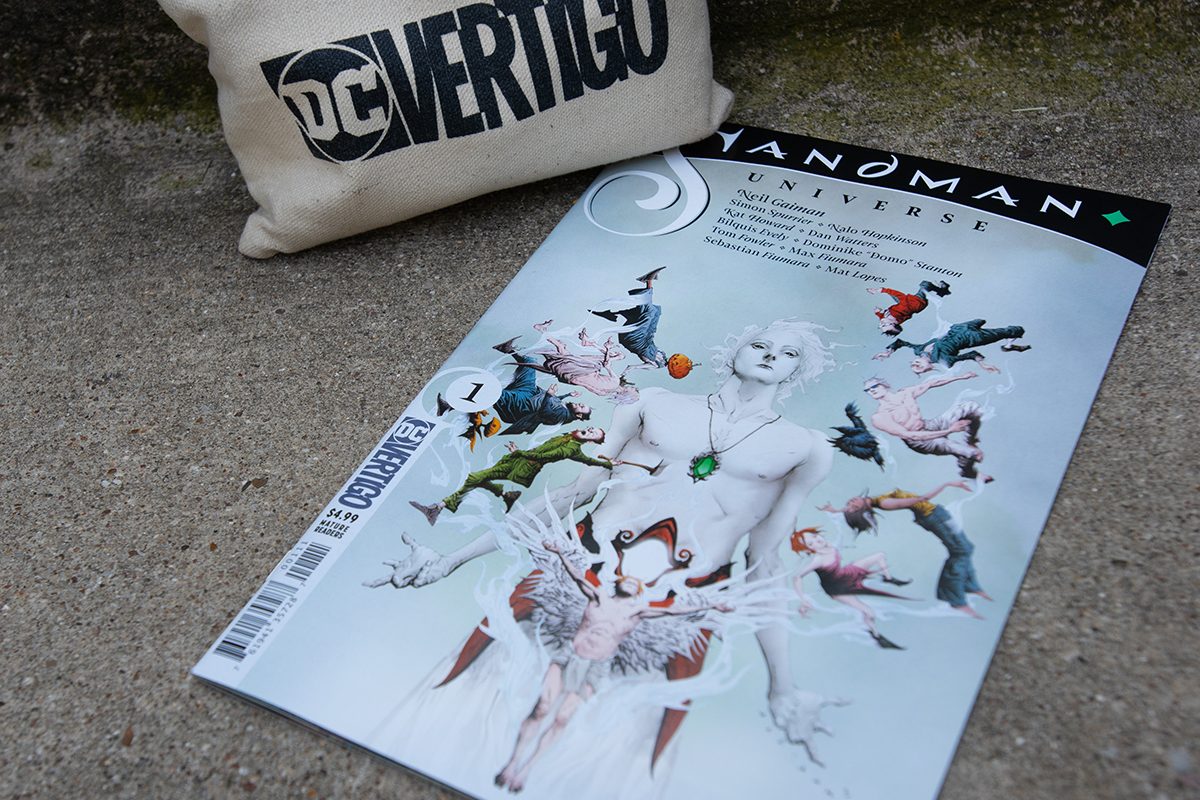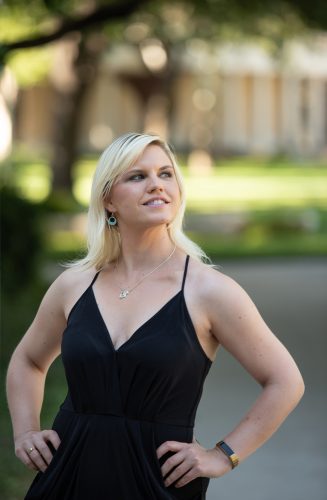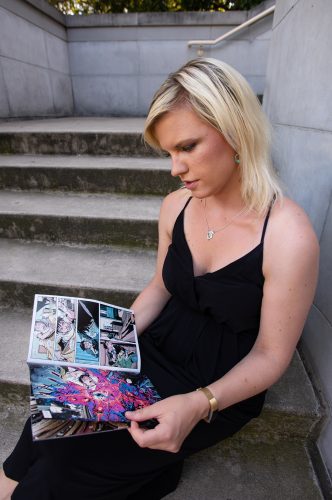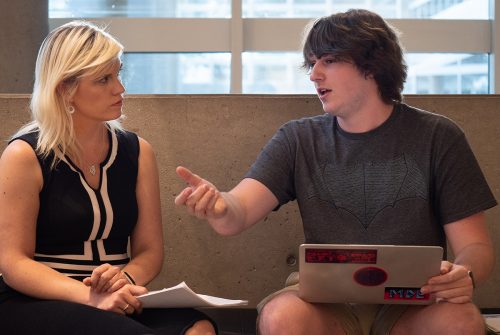
Photo by Glen E. Ellman
Through Comics and Video Games, Molly Mahan Tells Stories
The senior narrative editor for Riot Games previously worked for DC Comics and Dynamite Comics.
Molly Mahan ’09 has spent her career telling new stories with old characters.

Molly Mahan is the senior narrative editor at Riot Games. Photo by Glen E. Ellman
At DC Comics, her portfolio included characters with 80 years of continuous publication history. Before that, Mahan managed characters at Dynamite Comics that Edgar Rice Burroughs wrote more than a century ago.
Remembering and respecting all of that comic history can have its pressures, but one project in particular carried a reputation: Neil Gaiman’s The Sandman.
More than 7 million copies of the mythological series had been sold around the world in nine languages. And Mahan was to edit its reboot.
Thirty years after Gaiman’s The Sandman was first published, new creative teams at DC Vertigo announced The Sandman Universe.
Mahan was editor for the DC Vertigo, Black Label and Young Animal groups. All three target mature readers.
“Working with Molly Mahan has been an absolute delight,” Gaiman said. “The mixture of knowledge and enthusiasm that she brought to making, editing and forming comics was absolutely fabulous.”
For Mahan, Gaiman (“my literal hero”) is special.
“His Sandman books were really formative for me at a time where I was thinking maybe I didn’t want to spend my time reading comics anymore,” Mahan said. “It completely blew my mind.”
Big battle scenes and descriptions of environments in novels were hard for Mahan to imagine when she was younger. She skipped those parts, she said.
“I’d limit myself to reading works that took place in a world that already looked familiar, so I could focus on the characters, emotional beats and ideas behind what’s going on,” she said. “I’d get hung up trying to see what the author was describing.”
Visual storytelling was the answer Mahan needed. For her, one of the main draws of visual storytelling is the amount of information relayed in a small space. She pointed to Albert Mehrabian’s 1971 study that found only 7 percent of communication is verbal. She said that theory is transferable.
Seeing characters in their environments helps readers learn more about them, Mahan said, versus being told what the character is thinking or feeling.
Mahan uses this understanding as she edits. She also credits her TCU education. “Having a strong critical-thinking background from my writing and philosophy classes especially helps when I read a script and ask: ‘Is this what we want to express here?’ ‘Is it helping the story, or is it distracting from the story?’ ”
“Having a strong critical-thinking background from my writing and philosophy classes especially helps when I read a script.”
Molly Mahan
The path to the career Mahan had dreamed of since age 13 wasn’t easy. After college she had stints as a technical writer and bookkeeper in California.
But she still worked to make media industry connections.
One day Mahan was at a comedy show hosted by the news network Geekscape where she overheard someone complaining about writing a review for Super 8. Mahan, who had seen the film the evening prior, told the person that she had thoughts about it. Mahan ended up writing the article.
Mahan became a staff writer for Geekscape, where she produced reviews and interviewed writers and artists at San Diego’s Comic-Con. She also had a feature called “Heroine Addicts,” about women’s issues in comics, film, television and video games.
That led to Dynamite Comics in New Jersey.

Molly Mahan edited titles from The Sandman Universe while working at DC Comics. Photo by Glen E. Ellman
Three years later, Mahan accepted an assistant editor position at DC Vertigo. She packed up her Mustang and moved back to California. She was promoted to editor within three years.
Mahan said there’s a comic book character who embodies every kind of struggle. There’s a comic for everyone.
“The medium is so vast and large that I want people to be able to know there’s more out there than musclemen punching each other in the face,” Mahan said. “It’s really just being able to see the medium for what it is: a medium rather than a genre.”
Richard Enos, emeritus Piper professor and Lillian Radford Chair of Rhetoric and Composition, recalled reciting Green Lantern’s power ring chant to Mahan and her classmates. He was exemplifying memory training from the oral culture of ancient rhetoric.
Years later, when Mahan landed at DC Comics, she mailed Enos two Green Lantern comics — one from the silver age, the other a new issue she worked on.
Enos is happy to see Mahan find a place for her passion, enthusiasm and diligence. “Everything we do at TCU is based upon the idea, ‘Is this really going to help nurture the kinds of students we want?’ ” he said. “To see it realized in real, concrete ways by students such as Molly is very gratifying.”
At DC Comics, Mahan edited more than 40 titles. Before that, she worked on more than 30 titles for Dynamite Comics, including The Twilight Zone and Grimm. Her high-level work ethic was clear even when she was a student. Enos — who taught Mahan, then an undergraduate, in his graduate-level class — said he isn’t surprised at her skill and talent because he ranked several of her papers as exceptional.
“Molly is tremendous at problem-solving and understanding the nature of language — seeing how it reflects our thoughts and sentiments,” Enos said. “Her best work is in front of her.”
This year Mahan accepted a senior narrative editor position at Riot Games.
A game called “League of Legend,” a multiplayer online battle arena, doesn’t sound like it would have much narrative. But Mahan said there can be pushback when a character is given a defined personality. “Doubly so if that champion becomes a cipher for the user who invested a lot of personal identity into that avatar. …
“Riot has a whole world with a myriad of characters to explore. And it’s only once the characters themselves have been pinned down can we know what stories should be told with them.”
In September 2018, Wesley Cray, assistant professor of philosophy, invited Mahan to the TCU campus. She led a discussion in his Philosophy and Comics course and participated in a public question-and-answer session.

While presenting a guest lecture at TCU, Molly Mahan listened to student Brad Ramsey’s ideas for a Batman comic. Photo by Glen E. Ellman
Brad Ramsey, a sophomore film, TV and digital media major at the time, sat on the edge of his third-row seat at the forum, leaning forward and nodding during Mahan’s presentation. The student, wearing a Batman T-shirt, was attentive in a crowd that was a mix of comics lovers and a handful of people who craned their necks to spot the extra credit sign-in sheet.
After the presentation, Ramsey waited for his turn to talk to the speaker. He attended Mahan’s lecture with a distinct motivation: “I have very serious career things to ask her,” he said.
Ramsey asked Mahan if they could discuss a project he was working on. The two left the nerdy merriment of professors and students to find a bench.
Mahan nodded with attention as Ramsey pitched his plot for the Batman comic he would write. He was prepared for Mahan’s questions: He handed over an outline. He had a rundown of instructions for illustration angles.
Mahan, whose name appears in the masthead of Batman comics and The Sandman Universe publications, said it’s important to learn by doing, even if it means going against the mainstream.
“I’m definitely starting to appreciate and understand more that we never are, we are always becoming,” Mahan said. “So, thanks, Star Trek, for that.”

Your comments are welcome
Comments
Related reading:
Features
Comics in the Classroom Spark Creative Thinking
The medium itself breaks boundaries, and this idea transfers to course subject matter.
Features, Research + Discovery
When Scripture and Superheroes Collide
Johnny Miles says modern superheroes and ancient Jews have a lot in common.
Features
The classroom (r)evolution
Active learning has been in place at TCU for years. But with multidisciplinary Rees-Jones Hall now open, students and professors have a new technology-rich, 21st century place to learn together.